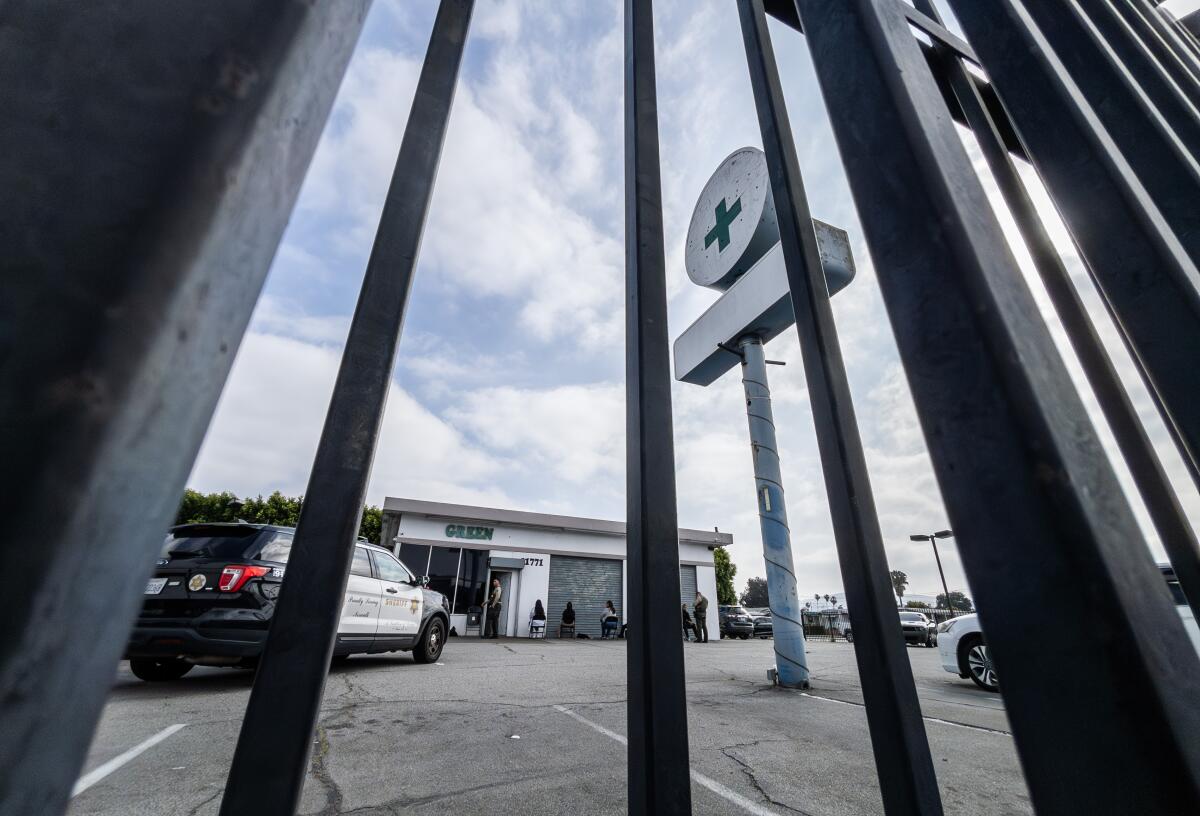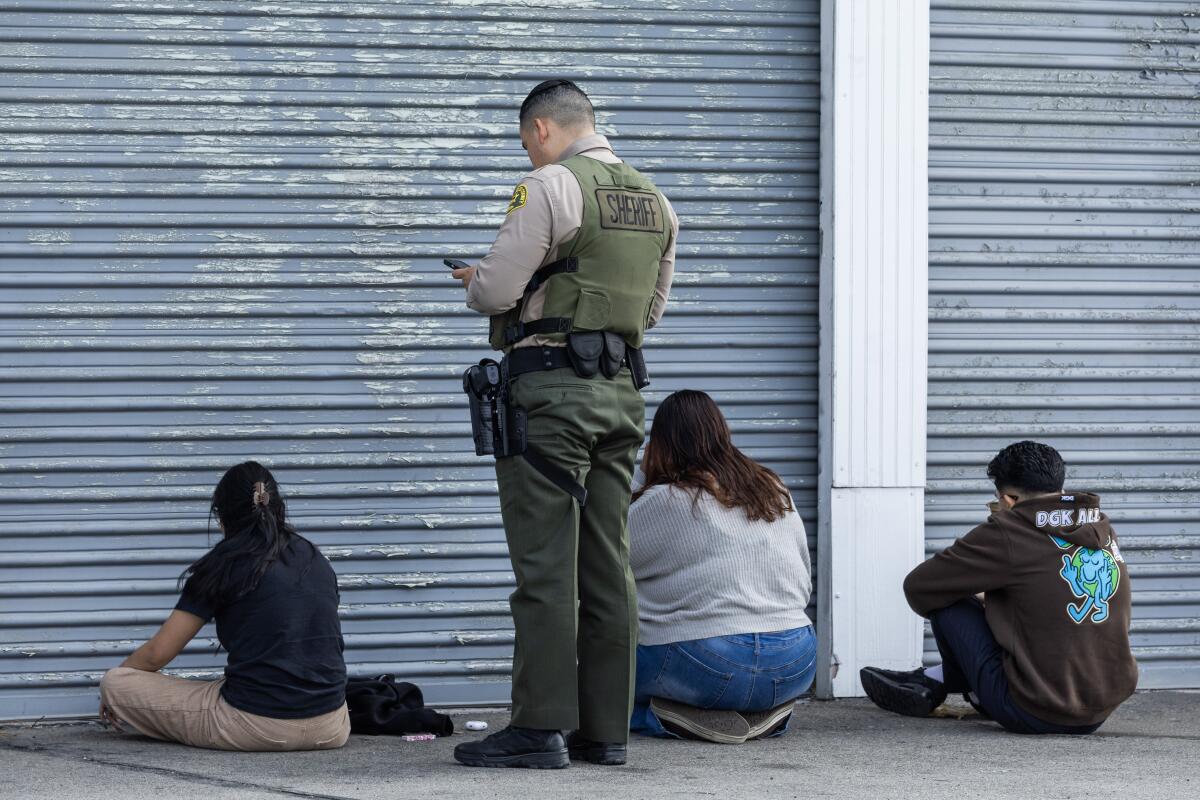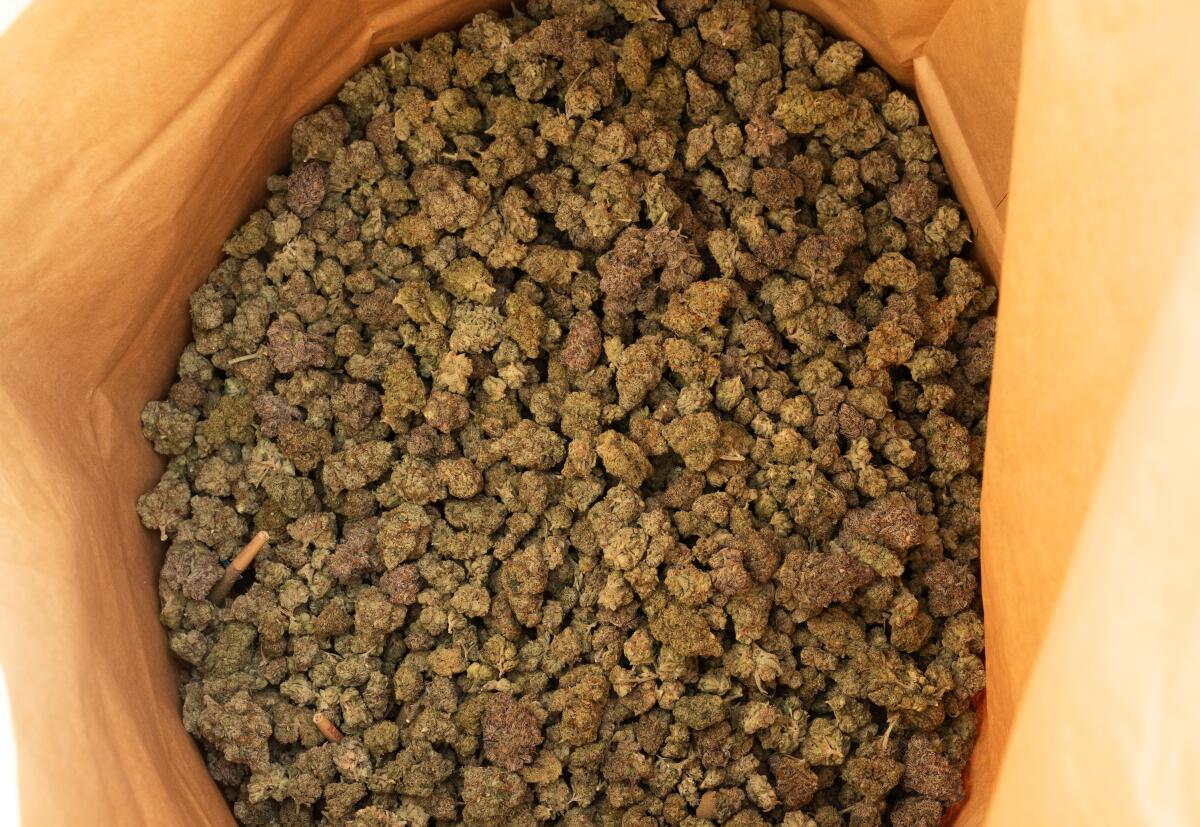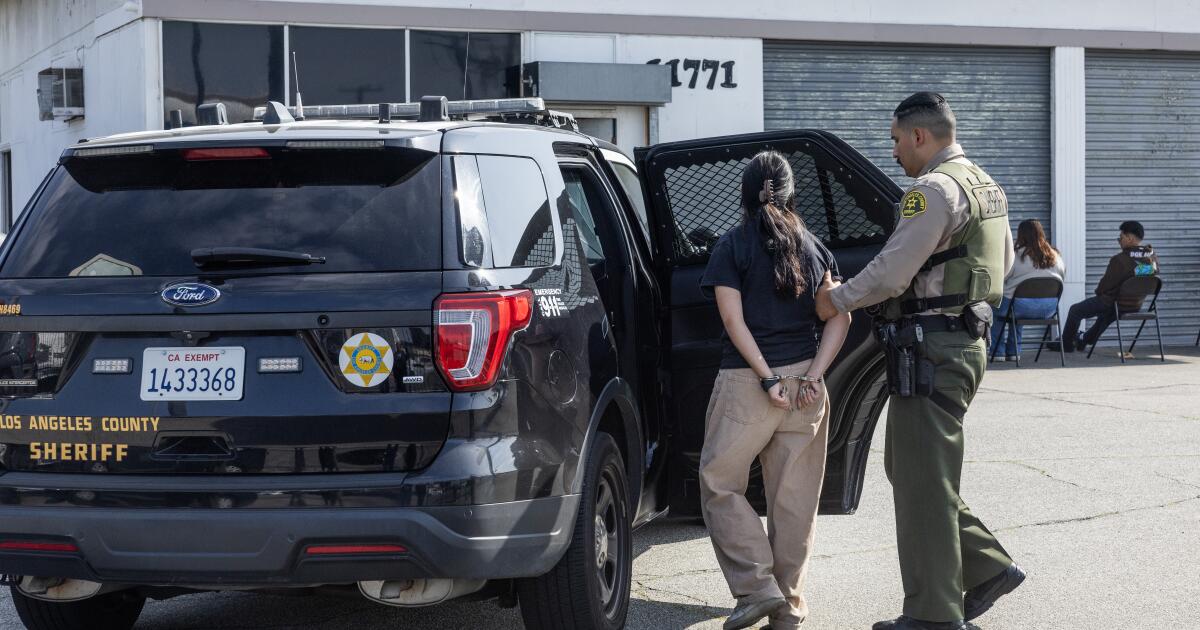The van slammed on its brakes in a parking lot on busy Whittier Street, and six men in army-green body armor and tactical helmets jumped out, guns drawn. Their target was Whittier Super Greens, a former used car dealership that had been converted into an illegal marijuana store.
“Los Angeles County Sheriff’s Department search warrant, present yourself,” one of the detectives yelled. Mexican pop music blared in the background as they entered the store and hustled employees and customers out. “Now, put your hands on us. Now.”
Less than five minutes into the raid on May 10, five people were sitting on metal folding chairs outside a corrugated metal garage door when an undercover agent emerged carrying a large brown bag containing marijuana and psilocybin mushroom products.
One employee was arrested and charged with possession of mushrooms, police released all other employees with a warning, and closed the store.
It opened again within a few weeks.
The temporary closure of Whittier Super Greens was the latest iteration of a cycle that has plagued county law enforcement for years.

A Pew Research Center study released in February found that Los Angeles County is home to about 1,500 marijuana dispensaries, but state data shows that just 384 are licensed in the county as of 2022.
(Myung J. Chung/Los Angeles Times)
Illegal dispensaries remain a common sight in Los Angeles County’s commercial districts, even as authorities have made hundreds of arrests and seized thousands of pounds of marijuana.
While local officials struggle to make progress, 125 miles to the south, the same problem has essentially been solved, where San Diego County officials say they have all but eradicated black market stores, which begs the question: Why can’t Los Angeles County do the same?
Officials from both countries say the solutions are complex but ultimately come down to a combination of political will, inter-agency coordination and cash.
Unlicensed stores generate millions of dollars in untaxed sales and often fill market demand in municipalities and unincorporated areas that have yet to license local marijuana sales, even though recreational marijuana was legalized statewide in 2016.
But while one county continues to fail, the other is getting creative, with a multi-pronged strategy that involves everyone, including tax collectors and the state Fish and Wildlife Department.
Lt. Jay Moss of the Sheriff’s Department’s Narcotics Division said the situation is so bad in Los Angeles County that many unlicensed marijuana stores are back up and running within hours of paying thousands of dollars in taxes and fees.
“We shut them down, and they reopened in a very short period of time,” Moss said. “It’s as if they understand that it’s the cost of doing business.”
Incentives to circumvent the rules
Less than two weeks after the Whittier Supergreens raid, the sheriff’s office’s early morning operation seemed as if it never happened.
On the afternoon of May 23, a man sat behind a dark window just inside the front door, gruffly checking IDs and ushering people into a back room where a variety of items were displayed in fluorescent-lit display cases.
Two young salespeople were showing a few customers cannabis flower and pre-rolls. A sign next to an electric rig warned people they were being given free “dabs” of high-THC wax: “Don’t cough on the budtender.”
Lt. Richard White of the Sheriff’s Department’s Drug Enforcement Bureau noted the store has been searched before and likely will be searched again.
“It’s certainly in their best interest to either relocate or reopen,” White said after he and his team wrapped up their enforcement action last month. “Why don’t these businesses continue to skirt the rules?”
Unlicensed dispensaries are inherently criminal and are associated with cartels and other outlaw groups.
Marijuana, edibles and e-cigarettes are often indistinguishable from legal marijuana except for their cheaper prices. Illegal products are not taxed or subject to state quality control regimes meant to protect consumers from heavy metals, pesticides and other hazards.
Many customers can’t tell if a store is licensed or not. Both types range from modest rooms with just a few shelves and a cash register to luxurious, well-appointed spaces with tasteful décor, high-end furniture and friendly staff that resemble an Apple Store more than a drug den.
After medical marijuana was legalized in California in 1996, dispensaries began to proliferate, some licensed by the state, but most not, becoming as common in many neighborhoods as drug stores and convenience stores.
According to a study released in February by the Pew Research Center, Los Angeles County is home to roughly 1,500 marijuana dispensaries, accounting for one-tenth of the total number of dispensaries believed to be operating in the nation.
But as of 2022, only 384 licenses exist in Los Angeles County, according to data from the state Bureau of Cannabis Control.

Los Angeles County sheriff’s deputies raided an illegal marijuana dispensary in Whittier on May 10 and detained employees. One person was charged with selling mushrooms, while four others were released with only a warning.
(Myung J. Chung/Los Angeles Times)
Raids like the one carried out last month in Whittier are part of an effort that even White, the detective involved in the investigation, acknowledged is not particularly strong or effective.
He said the county’s small team, the Cannabis Consumer Health and Safety Task Force, has only raided two to four illegal establishments a month over the past year, mainly in response to resident complaints.
That’s a much slower pace than in the past: Between October 2021 and April 2022, the department reported executing search warrants at more than 122 dispensaries, making more than 277 arrests and seizing thousands of pounds of marijuana and edibles.
The slowdown is partly budget-related: Counties pay deputies overtime for participating in operations rather than targeting dispensaries as part of their daily operations. Local governments that contract with the sheriff’s department cover the costs of operations in their jurisdictions.
The county allocated more than $2 million in one-time overtime funds to a multi-agency county task force to crack down on illegal dispensaries in unincorporated areas in 2021. But hundreds of thousands of dollars of that money went unspent, according to county budget records, and the county has refrained from such sweeping enforcement efforts since then.
“There are big shadowy organizations that run these pharmacies and they’re very profitable,” White said, “while on our side we have limited manpower and funding to tackle this problem.”
“Lots of friends”
The problems plaguing White are all too familiar to a colleague three hours’ drive south: San Diego County Sheriff’s Sergeant Nick Baccaris, who leads a team of detectives that has been tasked with busting unlicensed marijuana businesses for the past decade.
“Three or four years ago, sales of marijuana and the like were at their height and it was pretty much the norm,” Buckliss said.
But now such stores are rare.
“I haven’t seen it in quite a while,” he said.
There is a lot of overlap in how the two counties operate.
In Los Angeles, the sheriff’s department’s efforts are coordinated with the state Bureau of Cannabis Control and the California Department of Taxation and Fee Administration, which White said can implement “tolling” to demand immediate payment of unpaid taxes. Utility companies sometimes join in, cutting off service.
The L.A. County Law Office is pursuing other avenues to stop illegal dispensaries, including asset forfeiture and civil lawsuits.
But a network of limited liability companies and fictitious names could render many of those efforts in vain, said Moss, of the sheriff’s office’s narcotics division.
San Diego County isn’t giving up that easily.
Buckliss said his team brought in “countless friends” after obtaining a search warrant for the illegal dispensary.
A California Department of Fish and Wildlife scientist will inspect the property for improper drainage, and you will be charged with a tax-related felony if you fail to pay your outstanding taxes on the spot.
If code inspectors find violations, the county water and power companies will cut off service and, in some cases, seize buildings.
Legal dispensary owners are also becoming more aggressive, in some cases filing lawsuits to create more trouble for their illegal competitors, Buckoulis said.
Most had no choice but to withdraw from the illegal industry, and those who persisted risked criminal prosecution, including money laundering charges, aimed at the operators.
The San Diego County Board of Supervisors allocated about $3 million to fighting illegal dispensaries in 2021. Instead of paying overtime for the Sheriff’s Department, the county created a dedicated enforcement team and hired additional support staff for the District Attorney’s Office.
Meanwhile, in Los Angeles County, the district attorney’s office may accuse an employee or two, and sometimes a business or building owner, of selling drugs or other violations, White said.
“The ultimate goal is to determine who is responsible for running the business, not just the workers in the building,” Moss said, “but that can be very difficult.”

Unlicensed stores generate millions of dollars in untaxed sales by satisfying market demand in municipalities and unincorporated areas that have yet to license marijuana locally, even though recreational marijuana was legalized statewide in 2016.
(Myung J. Chung/Los Angeles Times)
“Shut down drug dens”
San Diego County hasn’t completely won the battle against illegal marijuana.
Licensed retailers complain that delivery services are driving much of their illegal business, and, as in Los Angeles, smoke-supply stores still often stock imitation marijuana products or those that secretly contain THC.
But brick-and-mortar moonshine sales are a thing of the past.
In Los Angeles County, Compton officials are trying to replicate that success.
As of last spring, it’s estimated that between 30 and 100 illegal marijuana dispensaries were operating within the city of Compton, serving customers in municipalities that staunchly banned regulated sales.
Councilman Andre Spicer said the numbers are down significantly from last year, but he doesn’t blame the Sheriff’s Department for any enforcement.
“This is no different than what we did in the ’80s and ’90s when we shut down drug dens. It’s illegal,” Spicer said. “Their motivation is money. But now we’re holding them accountable.”
The city of Compton pays the Sheriff’s Department $20 million a year for law enforcement services, but pharmacy raids are added as an “a la carte” service that Spicer estimates cost the city about $20,000 apiece.
The councilman explained that a raid would result in a $2,500 fine and cost the city $17,500, with little to no success. “Then we can’t afford to shut them down,” he said.
Compton’s city council voted to disband its police department in 2000, citing inefficiency, a decision Spicer laments.
“If I’m in charge of a police department, I tell them how to operate, how to operate, what to focus on,” Spicer said. Of the sheriff’s department, “It’s political. They want money. ‘If it’s not in the contract, we’re not going to shut something down for free.'”
Recently, the city has been trying to fight the case in court.
In late 2022, the city of Compton launched an illegal dispensary task force and is working with an outside law firm to collect fees and unpaid taxes from illegal dispensaries and the landlords who rent to them, a tactic that critics say in some cases places an unfair burden on lower-level employees.
But Spicer said the task force has been successful in identifying and shutting down dozens of illegal businesses.
He said financial commitment was key, as in previous years, illegal operators repeatedly engaged in illegal activities simply because they could make a profit.
Spicer said that shortly after the city “bulldozed” the illegal dispensary before the court action could be implemented, employees “were sitting in the storefront, stopping customers as they came in and giving them the address of the new location along with discount cards.”

